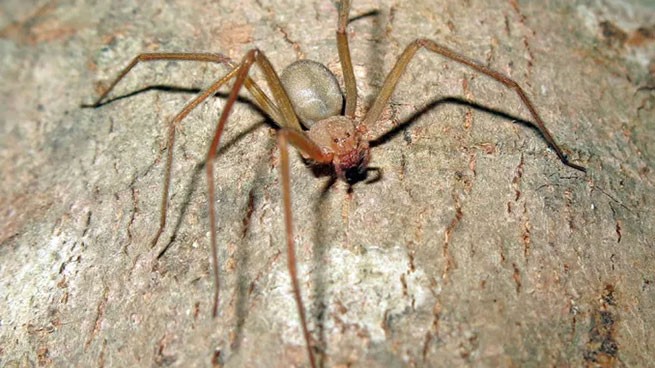After second case deaths from the bite of the “red spider” (Loxosceles rufescens) we add it to the list deadly insects Greece to be wary of.
Fortunately, in Greece there are only two species of spiders that are deadly to humans – the red spider (Loxosceles rufescens) and the Mediterranean Black widow (Latrodectus tredecimguttatus).
You can read about the “Black Widow” or karakurt Here.
Red Spider (Loxosceles rufescens)

Loxosceles rufescens (lat.) is a species of spider from the Sicariidae family. It originates from the Mediterranean region (including Greece), but is now distributed throughout the world.
The bite is dangerous for humans (causes arachnoses loxoscelism)
Loxosceles rufescens has venomous fangs that transmit cytotoxins and proteolytic enzymes, causing toxic effects on humans. from light to heavy. Bites may result in necrosis, systemic symptoms, or rare complications. When hunting, paralysis occurs with the help of venom, which can lead to an accidental bite of a person for defensive purposes.
However, only one fatal case has been reported in 2016 (until August 2024), and even this incident remains controversial as the spider was not captured or identified and the person affected suffered from an autoimmune disorder (myasthenia gravis).
Bites from loxosceles rufescens on humans are usually in case of self-defense, when they are pressed into the skin, causing localized necrosis. The spider injects venom through hollow fangs, and bites are often incidental due to its inconspicuous nature rather than aggressiveness.
Loxoscelism — arachnosis caused by the bite of spiders of the genus Loxosceles, most often the bite of the brown spider; the disease is characterized by extensive necrosis of the skin and subcutaneous tissue.

A person 31 hours after a bite.
A spider bite often goes unnoticed, but in most cases the sensation is similar to that of a needle prick. Then, for 2-8 hours, only pain and itching bother. Then the situation develops depending on the amount of poison that has entered the blood.
In severe cases, loxoscelism is characterized by a gangrenous scab at the site of the bite, nausea, malaise, fever, hemolysis, and thrombocytopenia. In most cases, the spider bite is minor and does not cause necrosis, but in large doses, the venom can provoke the formation of a necrotic ulcer that destroys soft tissue. The ulcer can reach 25 mm or more in diameter, and after healing, which takes 3-6 months, a depressed scar remains.

Tissue necrosis caused by the bite of the spider Loxosceles reclusa (similar to the bite of the red spider Loxosceles rufescens)
The transparent viscous venom of this spider contains esterase, alkaline phosphatase, protease and other enzymes that cause tissue necrosis and hemolysis. The main role in the development of necrosis belongs to sphingomyelinase D, which binds to cell membranes and causes neutrophil chemotaxis, vascular thrombosis and the Arthus phenomenon. In the case of subcutaneous tissue necrosis, healing can take up to 3 years.

Scars left after recovery
In rare cases, general symptoms from internal organs appear. Most deaths occur in children under seven years of age, people with a weak immune system, and the elderly. Hemolytic anemia, hemoglobinuria, and renal failure can cause death. The symptoms of a bite from the red spider (Loxosceles rufescens) are similar to a bite from (Loxosceles reclusa), but noticeably weaker:
- Intense burning sensation in the area of the bite.
- Sweating.
- General malaise.
- Rash.
- Approximately 12 to 36 hours after the bite, a characteristic pattern of discoloration will form at the bite site.
- The bite site turns a deep purple or blue color, with a white ring forming around it, usually surrounded by a large red area.
- The bite wound may persist and remain open for weeks or months.
Toxic to animals
Loxosceles rufescens is known for its defense mechanism that repels predators by causing discomfort upon contact. This organism secretes a toxin that, although mild in intensity, can affect both humans and a variety of animals. During both its larval and adult stages, loxosceles rufescens does not actively secrete venom, but can cause mild toxicity upon contact. For example, humans may experience skin irritation, and pets such as dogs and cats may show signs of discomfort. Birds and other insects may also experience adverse reactions if they come into contact with loxosceles rufescens.
Do not attempt to self-medicate. Seek immediate medical attention if bitten.

First aid for a bite
If bitten, first of all, you should remain calm and call a doctor. Apply ice to the bite. The affected limb should be immobilized. Do not apply a tourniquet or squeeze out the poison. To disinfect the wound, use antiseptics, and to reduce pain, use aloe juice. If possible, catch the spider in a clean and secure container for identification by an expert.
There are many treatment options for bite scars, with varying degrees of effectiveness: hyperbaric oxygen, dapsone, antihistamines (eg, cyproheptadine), antibiotics, dextran, glucocorticoids, vasodilators, heparin, nitroglycerin, electric shock, curettage, surgery, and antivenom. None of these options have been tested to determine effectiveness. Most bite scars resolve without any medical intervention.
Unfortunately, there is no antidote for the bite of Loxosceles rufescens (at least in Greece).
Precautionary measures
To avoid spider bites, you should:
- shake out clothes and shoes thoroughly before using them;
- check bedding and toilet before use;
- wear gloves when carrying firewood, timber and stones (it is worth checking the gloves themselves before doing this);
- remove boxes from under the beds; move the beds themselves away from the walls;
- Be careful with boxes – spiders often hide in them.
Sanitation:

- get rid of trash, old boxes and clothes, piles of stones and other unnecessary things in a timely manner;
- tidy up the toilet, basement, garage, attic and outbuildings;
- do not store timber in front of the house;
- do not allow the presence of dead insects in the house, which the spider feeds on;
Other measures:
- use duct tape to catch spiders;
- thoroughly dust and vacuum indoor areas to remove spiders, cobwebs and spider eggs (dust bag contents should be disposed of in a trash container outside the home);
- To kill individual insects, use a rolled-up newspaper or fly swatter.
Insecticides

There are many spider control products available. Some are designed for home use, while others are for licensed use only. If you have found a brown recluse spider in your home, it may be wise to contact a professional pest control company.
Research shows that newly developed pyrethroids (e.g. cyfluthrin, cypermethrin, etc.) are somewhat effective against the brown recluse spider. Wettable powders and microencapsulated “slow release” formulas provide long-term activity and are preferred for use as emulsion sprays.
Insecticide treatments should be applied in a manner that brings the chemical into contact with as many spiders and their webs as possible. Aerosols should be applied to the outside perimeter of the home (including under eaves, patio and boards, and behind window shutters), baseboards, corners, and other areas where spiders are likely to be nesting. Powders should be applied to crevices and other hard-to-reach areas where spiders may be hiding. Aerosol agents such as pyrethrin, while not very effective on their own, may encourage the spider to stick closer to the treated surface.







More Stories
Thessaloniki: Man convicted of using fake diploma
Thessaloniki: Man smashes neighbor's car with axe
Hair: 40-year-old man shoots 69-year-old father in head with harpoon